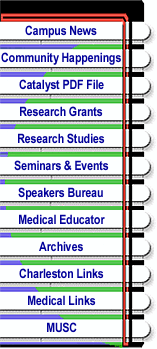


|
Women most likely victims of abuseby Dick PetersonPublic Relations Domestic violence “happens to people just like us,” a local shelter representative told health professionals gathered in November for a nursing grand rounds. Statistics she recited heightened the possibility that abuse victims were among those attending her presentation, most of whom were women. Susan Johnston, who volunteers at My Sister’s House, a shelter for abused women and their children, said that the major health problem few talk about often goes unrecognized and untreated in clinical settings. Emergency room personnel, especially, should know what domestic violence consists of, learn how to ask the right questions and understand the most effective treatments for its victims. “Battering is the number-one cause of injury to women in the U.S. It accounts for more injury to women than stranger rapes, muggings and car accidents combined,” Johnston said. And women, by far, are the more likely victims of domestic abuse. One in three women will experience abuse in their life, she said. Couching her presentation on domestic violence as physical, sexual and psychological abuse against women, Johnston advised her audience to be aware of the possibility that any female patient may well be the victim of abuse. A sickening litany of abuse statistics from the American Medical Association examined the enormity of the problem. Beyond obvious physical injury, domestic violence contributes to chronic health problems that clinicians could more effectively treat, if only they knew. Citing a predictable “cycle of violence” that should alert women to the specter of increasing domestic violence, Johnston said that it begins with a tension-building environment of minor verbal and physical threats that the woman tries to placate by “walking on eggshells.” Usually this is followed by an ultimatum—an unreasonable set-up—to which the partner reacts violently with sexual or other physical battering to “teach the woman a lesson” or to emphasize his power over her. Then comes the “illusion of bliss.” Johnston says it’s the “honeymoon” part of the cycle where the batterer tries to redeem himself with promises not to be violent again. “Don’t act shocked,” Johnston advised the clinicians in attendance. “Remain relaxed and caring.” Domestic violence is so common in women’s lives, especially so among those seeking medical attention, that it should be screened routinely, she said. A list of sample screening questions generally follow a “Many patients tell me....Is this happening to you?” pattern. Another: “Sometimes people...may use physical force. Is this happening in your situation?” They go from general to specific and from observations (of bruises, for example) to what caused them. The questions are purposely made to seem routine, but caring so as not to alienate the patient. Johnston also offered steps to be taken in developing a safety plan, preparations a domestic violence victim can make to safely separate herself from her abuser. But the steps imply that a pattern of abuse has already been established. So, why would a woman, a victim of domestic violence, stay in that situation even after the first incident? “They can be fearful of danger to themselves or their children. They may be economically dependent. They may fear losing custody of their children, lack housing or job skills to live independently. They may be socially isolated with few alternatives but to stay. They may fear the court process that could ensue, or be constrained by cultural or religious controls and guilt. And there’s always the hope or belief that the partner will someday change,” Johnston said. “There will be patients who for one reason or another are not ready to leave their situation,” Johnston said. She said that assisting an abuse victim to form a safety plan will enable her to gain some control over her life. Developing a Safety PlanDefinition: A safety plan is a plan of action designed to help keep the woman and her children as safe as possible, if she is unwilling or unable to leave her situation.
Those seeking more information or interested in volunteering may also call. Catalyst Online is published weekly, updated as
needed and improved from time to time by the MUSC Office of Public Relations
for the faculty, employees and students of the Medical University of South
Carolina. Catalyst Online editor, Kim Draughn, can be reached at 792-4107
or by email, catalyst@musc.edu. Editorial copy can be submitted to Catalyst
Online and to The Catalyst in print by fax, 792-6723, or by email to petersnd@musc.edu
or catalyst@musc.edu. To place an ad in The Catalyst hardcopy, call Community
Press at 849-1778.
|